 To enhance service speed and avoid tariff delays, we've opened a US warehouse. All US orders ship directly from our US facility.
To enhance service speed and avoid tariff delays, we've opened a US warehouse. All US orders ship directly from our US facility.
| Cat. No. | Product Name | Field of Application | Chemical Structure |
|---|---|---|---|
| DC48753 | DC-LC3in-D5 Featured |
DC-LC3in-D5 acts as an autophagy inhibitor by attenuating LC3B lipidation. DC-LC3in-D5 binds with LC3B. DC-LC3in-D5 disrupts the LC3B-LBP2 interaction with an IC50 of 200 nM. DC-LC3in-D5 may contribute to anti-HCV or combination treatments in cancer through inhibiting autophagy.
More description
|

|
| DC60834 | LXG6403 Featured |
LXG6403 is a potent, irreversible lysyl oxidase (LOX) inhibitor with an IC₅₀ of 1.3 μM in MDA-MB-231 cells, demonstrating approximately 3.5-fold selectivity over LOXL2 and no activity against LOXL1. It effectively inhibits LOX activity across multiple triple-negative breast cancer (TNBC) cell lines, including HCC143, Hs-578-T, and HCC1937, with IC₅₀ values below 5 μM. In preclinical models, LXG6403 enhances chemosensitivity to agents such as doxorubicin, cisplatin, and paclitaxel by disrupting collagen crosslinking, thereby reducing tumor stiffness, improving drug penetration, inhibiting FAK signaling, and inducing ROS-mediated DNA damage leading to G1 arrest and apoptosis. Notably, in the TM01278 TNBC patient-derived xenograft model, LXG6403 overcame doxorubicin resistance without significant toxicity, underscoring its potential as a therapeutic agent in LOX-driven, chemoresistant cancers
More description
|

|
| DC60833 | Rtioxa-43 Featured |
RTIOXA-43 is a dual orexin receptor agonist exhibiting potent activity at both OX1 and OX2 receptors, with EC₅₀ values of 24 nM for each . In vivo studies involving 12-month-old mice have demonstrated that peripheral administration of RTIOXA-43 significantly increases wakefulness, reduces total sleep time, and enhances sleep/wake consolidation by decreasing the number of sleep episodes and extending their duration . These findings suggest that RTIOXA-43 holds promise as a therapeutic candidate for treating orexin-deficient conditions such as narcolepsy.
More description
|

|
| DC22090 | ER-464195-01 Featured |
ER-464195-01 is a specific, orally active inhibitor that inhibits Calreticulin (CRT) binding to integrin α subunits (ITGAs) with IC50 of 0.17, 0.36, and 0.23 uM in the interaction between CRT and ITGA α4, αL, and αM/α2/α5.
More description
|

|
| DC60832 | GJG057 Featured |
GJG057 is a LTC4S inhibitor. GJG057 exhibits potent cytotoxic effects against various human cancer cell lines, including SGC-7901, HGC-27, and MCF-7, with IC₅₀ values of 20.5 ± 5.93 μM, 3.3 ± 2.53 μM, and 16.6 ± 0.75 μM, respectively. Notably, GJG057 shows high selectivity towards cancer cells over normal cells. Mechanistic investigations revealed that GJG057 induces apoptosis in a concentration-dependent manner and downregulates the expression of HIF-1α, VEGF, and PKM2, leading to decreased lactate production. Furthermore, GJG057 effectively inhibits tubulin assembly, suggesting its potential as a multi-target anti-tumor agent.
More description
|
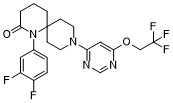
|
| DC73897 | AGF347 Featured |
AGF347 (AGF-347) is a small molecule inhibitor targeting mitochondrial C1 metabolism at SHMT2 (in vitro Ki=2.19 uM), also directly targers the purine biosynthetic enzymes GARFTase (Ki=3.13 uM) and AICARFTase (Ki=3.72 uM), and SHMT1 (Ki=2.91 uM).
More description
|

|
| DCC0193 | 2-furoyl-ligrlo-amide Featured |
2-Furoyl-LIGRLO-amide is a potent and selective proteinase-activated receptor 2 (PAR2) agonist with a pD2 value of 7.0.
More description
|

|
| DC23017 | R 59022 Featured |
A small molecule inhibitor of diacylglycerol kinase (DGK) with IC50 of 2.8 uM, inhibits the phosphorylation of OAG to OAPA with IC50 of 3.8 uM in intact platelets.
More description
|

|
| DC60831 | VLS-1272 Featured |
VLS-1272 is an orally bioavailable, potent, ATP non-competitive, microtubule-dependent, and highly selective inhibitor of KIF18A. VLS-1272 is selective for KIF18A over other kinesins, with no inhibition of KIF11/Eg5, KIF18B, or KIFC1 at 100 µM, and IC50 of 280 nM against KIF19. VLS-1272 treatment results in mitotic defects leading to substantial, dose-dependent inhibition of tumor growth.
More description
|
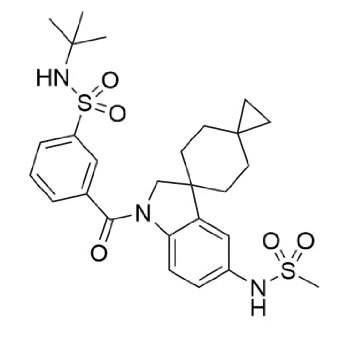
|
| DC60830 | HM-279 Featured |
HM-279 is a potent ALK5 inhibitor with IC50 of 4.7 nM. HM-279 shows cross-reactivity with ALK7 (IC50 of 6.8 nM), but HM-279 has fair to good selectivity against other TGF-β receptor family kinases, with 4.5-693 fold selectivity.
More description
|
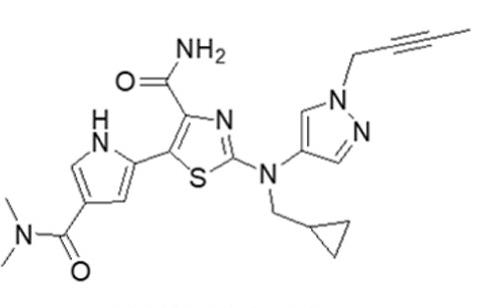
|
| DC60829 | DGEM3 Featured |
dGEM3 is a novel VHL molecular glue that targets the survival of motor neuron (SMN) complex member GEMIN3 for degradation. dGEM3 demonstrated a remarkable degree of selectivity for GEMIN3 recruitment directly out of the DEL screen with no other DEAD-box helicases showing any indication of recruitment or degradation.
More description
|
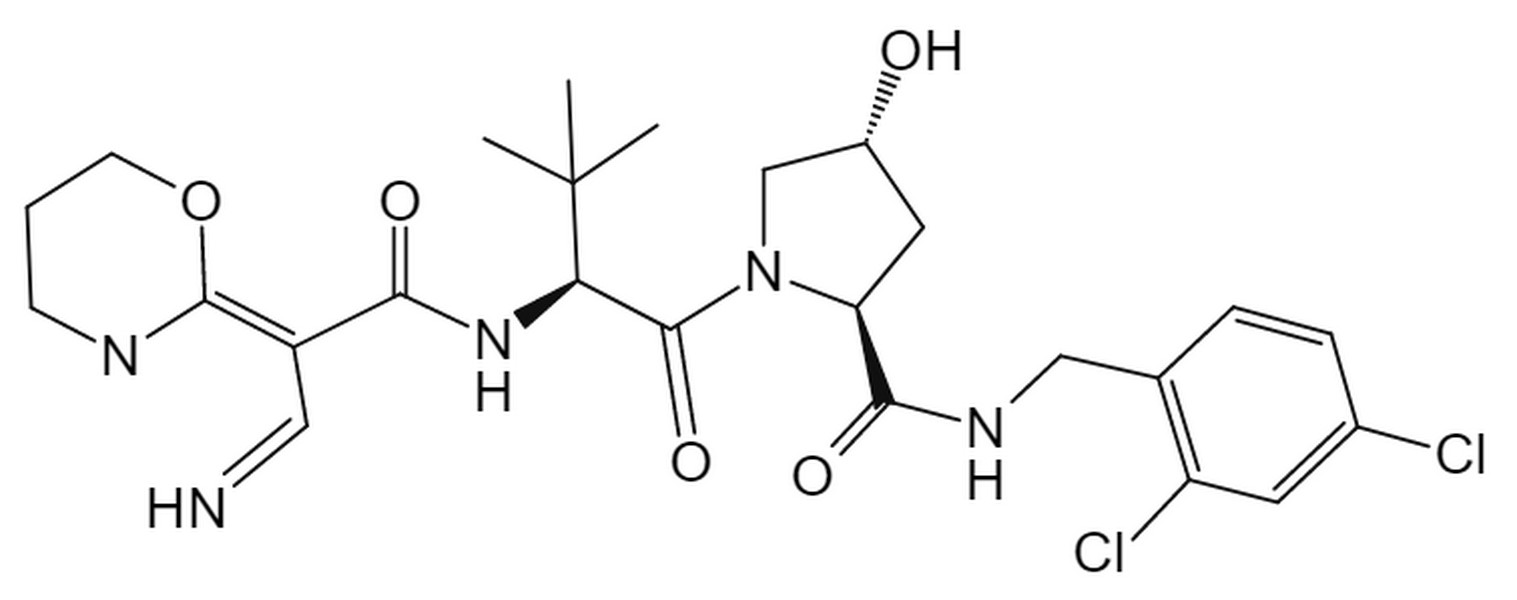
|
| DC60462 | MIC1 Featured |
MIC1 is a set of multi-charged lipids with four tertiary amino nitrogen atoms (4N4T) which could be constructed and applied to form novel lipid nanoparticles. 4N4T-LNPs based on MIC1 exhibit much higher mRNA translation efficiency than the approved SM-102-LNPs. 4N4T-LNPs are successfully applied to DS mRNA vaccine and the vaccines worked well against SARS-CoV-2 and its variants, including Delta and Omicron.
More description
|

|
| DC66649 | CP-LC-1254 Featured |
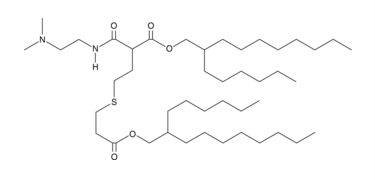
|
|
| DC21219 | LBL1 Featured |
LBL1 is a first-in-class pyrroloquinazoline small molecule that selectively targets the coiled-coil domain of lamin A (binding affinity Kd = 5.11 μM), demonstrating potent anticancer effects through nuclear lamina disruption.
More description
|

|
| DC60681 | SD-436 Featured |
SD-436 is a highly potent and selective STAT3 degrader with DC50 of 0.1 nM in human PBMCs and displays >10,000-fold degradation selectivity for STAT3 over other STAT proteins.
More description
|

|
| DC70765 | SD-36 Featured |
SD-36 (STAT3 degrader SD-36) is a potent, selective STAT3 degrader (PROTAC), potently induces the degradation of STAT3 protein in vitro and in vivo.SD-36 is designed using an analogue of CRBN ligand lenalidomide and the STAT3 inhibitor SI-109, binds to recombinant STAT3 protein with Ki of 11 nM.SD-36 (250 nM) depleted >90% of STAT3 protein in MOLM-16 cells after 4 hr treatment and >50% of STAT3 protein in DEL, KI-JK and SU-DHL-1 cells after 7 hr treatment, also efficiently degraded STAT3 protein in murine cells.SD-36 displays extremely high cellular selectivity for degradation of STAT3 over other STATs.SD-36 effectively degrades both wild-type and mutated STAT3 proteins in cells, effectively degrades mutated STAT3 (D661Y, K658R mutant), also effectively degrades CRISPR-mutated homozygous Y705F mutant STAT3 protein in DLD-1/STAT3Y705F/Y705F cells.SD-36 displayed strong growth-inhibitory activities in a subset of leukemia and lymphoma cell lines (MOLM-16 cell line IC50, 35 nM), 100-fold more potent than SI-109.SD-36 (i.v. 25 mg/kg) effectively and selectively depletes STAT3 protein, achieves complete and long-lasting tumor regression in in mouse xenograft tumors.
More description
|

|
| DC65211 | KT-474 Featured |
KT-474 is a highly active and selective, orally bioavailable IRAK4 degrader being developed for the treatment of toll-like receptor (TLR)/interleukin-1 receptor (IL-1R)-driven immune-inflammatory diseases.
More description
|

|
| DC65324 | NX-2127 Featured |
NX-2127 is a potent, selective, and orally bioavailable BTK degrader with Kd of 18 nM (for WT BTK), 45 nM (BTK C481S), 18 nM (BTK T474I), 44 nM (BTK M437R), 97 nM (BTK V416L), and 88 nM (BTK L528W), respectively. NX-2127 efficiently engages the intracellular ubiquitin-proteasome system to simultaneously bind both BTK and the CRBN E3 ubiquitin ligase complex, inducing polyubiquitination and proteasome-dependent degradation of BTK, IKZF1, and IKZF3.
More description
|
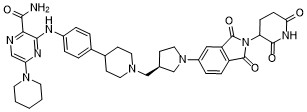
|
| DC44798 | ARV-110 Featured |
ARV-110 is an orally active, specific androgen receptor (AR) PROTAC degrader. ARV-110 promotes ubiquitination and degradation of AR. ARV-110 can be used for the research of prostate cancer.
More description
|

|
| DC71669 | ARV471 Featured |
ARV471 is an orally bioavailable estrogen receptor-targeting (ER-targeting) PROTAC for the treatment of patients with locally advanced or metastatic ER+/HER2- breast cancer.
More description
|

|
| DC67462 | YJ1206 Featured |
YJ1206 is an orally bioavailable PROTAC compound that selectively degrades CDK12 and CDK13, demonstrating potent activity (IC50 = 12.55 nM) in VCaP cells. It induces DNA damage, triggers apoptosis, and drives tumor regression in treatment-resistant prostate cancer PDX models, highlighting its therapeutic potential.
More description
|

|
| DC41141 | endo-BCN-O-PNB Featured |
endo-BCN-O-PNB is an alkyl/ether-based PROTAC linker that can be used in the synthesis of PROTACs.
More description
|

|
| DC70359 | DK1-04e Featured |
DK1-04e serves as a prodrug for the potent SIRT5 inhibitor DK1-04 (IC50 = 340 nM), demonstrating significant anti-tumor activity in breast cancer models. The compound effectively suppresses mammary tumor progression in both MMTV-PyMT transgenic mice and human xenograft models, with cellular studies confirming SIRT5 inhibition disrupts cancer cell proliferation and transformation.
More description
|

|
| DC60827 | Lirafugratinib (RLY-4008) Featured |
Lirafugratinib (RLY-4008) is a highly selective irreversible inhibitor of FGFR2 with IC50 of 3 nM. Lirafugratinib shows substantial selectivity over FGFR1 (~250-fold) and FGFR4 (~5,000-fold) in vitro, causes tumor regression in multiple FGFR2-altered human xenograft models.
More description
|
.png)
|
| DC65519 | TNG462 Featured |
TNG462 is a potent and selective MTA-cooperative PRMT5 inhibitor. TNG462 has a PRMT5-MTA Ki < 300 fM, HAP1 MTAP-null cellular SDMA IC50 of 800 pM and viability GI50 of 4 nM, an average 45-fold selectivity against MTAP WT cells.
More description
|
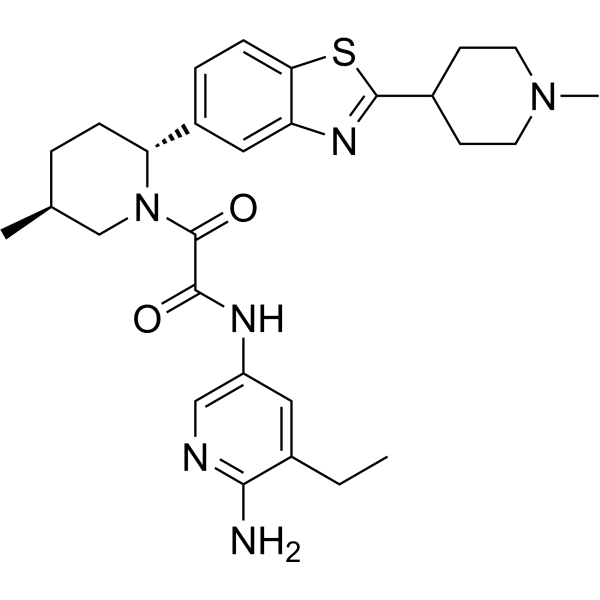
|
| DC60826 | PZL-A Featured |
PZL-A is a first-in-class activator of mtDNA synthesis that is capable of restoring function to the most common mutant variants of POLγ. PZL-A binds to an allosteric site at the interface between the catalytic POLγA subunit and the proximal POLγB subunit, which is unaffected by nearly all disease-causing mutations.
More description
|

|
| DC22532 | GNE-049 Featured |
GNE-049 (GNE049) is a potent, selective, orally available inhibitor of CBP/p300 bromodomain with biochemical IC50 of 1.1/2.3 nM, respectively.
More description
|

|
| A725 | Eptinezumab Biosimilar(Anti-CALCA / CGRP Reference Antibody) Featured |
Eptinezumab is a humanized monoclonal antibody. Eptinezumab binds to calcitonin gene-related peptide (CGRP) and blocks its interaction with the receptor. Eptinezumab is used for the prevention of migraine in adults.
More description
|
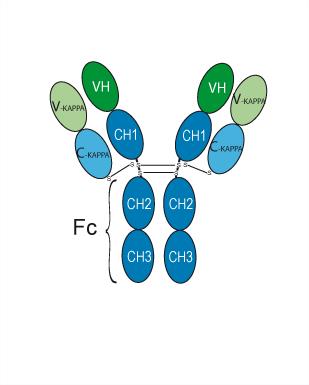
|
| DC60343 | UDP-GlcNTFA.2Na Featured |
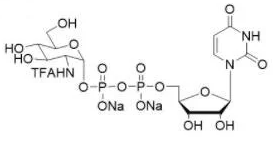
|
|
| A724 | Girentuximab Biosimilar(Anti-CA9 / CAIX Reference Antibody) Featured |
Girentuximab (G250) is a chimeric monoclonal antibody that binds carbonic anhydrase IX (CAIX), a cell surface glycoprotein ubiquitously expressed in clear cell renal cell carcinoma (ccRCC).
More description
|

|